
How to stake up garden plants
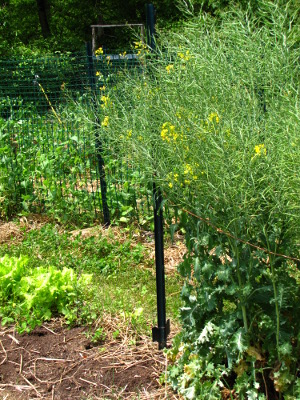 Even though staking up plants
seems absurdly simple, we've gone through a lot of trial and error
before finding techniques that work for us. But first --- why tie
up plants at all?
Even though staking up plants
seems absurdly simple, we've gone through a lot of trial and error
before finding techniques that work for us. But first --- why tie
up plants at all?
We stake plants in our
vegetable garden for their own good and to make our lives easier.
Staking tomatoes (combined with pruning) keeps the leaves drier,
which holds off blight in hot, humid climates like ours. After
you stop picking your asparagus, the tall fronds can easily become top
heavy and snap off during windy or wet weather, and I've found the same
is true of plants like kale when you let them fruit in order to collect
the seeds. Then there's the fact that it's annoying to have to
lift up those tall plants sprawling across the aisle every time you
want to push a wheelbarrow or mower through.
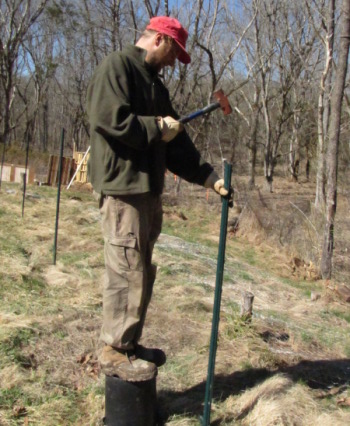 We've tried lots of different
materials and methods for staking plants, and my favorite by far uses
light-weight metal fence posts. (These are often called "U-posts"
because they're shaped like a U in cross-section.) Heavy T-posts
are too hard to pound in (and to take back
out when you need to move your stakes), while free materials like
branches and bamboo have a tendency to rot and break at just the wrong
moment. Although fence posts are expensive when bought in large
quantities, they also last a very long time if you're nice to them ---
we expect ours to keep going for a decade or two.
We've tried lots of different
materials and methods for staking plants, and my favorite by far uses
light-weight metal fence posts. (These are often called "U-posts"
because they're shaped like a U in cross-section.) Heavy T-posts
are too hard to pound in (and to take back
out when you need to move your stakes), while free materials like
branches and bamboo have a tendency to rot and break at just the wrong
moment. Although fence posts are expensive when bought in large
quantities, they also last a very long time if you're nice to them ---
we expect ours to keep going for a decade or two.
If your soil's soft, you
can push your posts in by jumping on the pegs at the bottom (imagine
the fence post is a pogo stick). Alternatively (especially in
hard soil), you can pound the posts in with a mini sledge hammer.
I usually ask Mark to pound in the posts 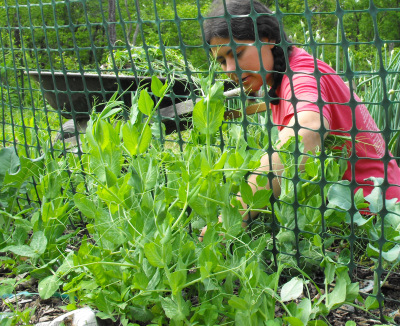 very solidly if they're going
to be in place all summer, but I just push them in the easy way for
more temporary applications.
very solidly if they're going
to be in place all summer, but I just push them in the easy way for
more temporary applications.
I've written before
about how to make a pea
trellis --- we still
make our trellises exactly the same way three years later because the
method works so well. (Well, we did invest in some taller U-posts
so we don't have to add the stick extensions, and we often put the
posts a bit closer together now.) We use the same kind of trellis
for cucumbers, and would use it for green beans too if we didn't grow
bush varieties.
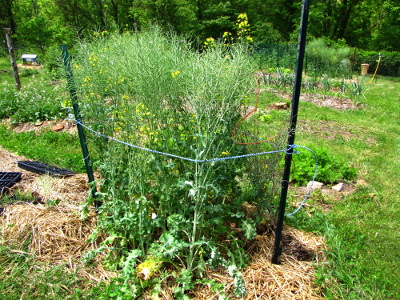 For
asparagus or other plants that grow in a big mass, I generally put a
post at each corner of the bed and tie a piece of wire, plastic baling
twine, or rope all the way around the plants. For my flowering
kale, I cut corners a bit and just used two posts per bed --- I figure
I can get away with this method since the kale will be done blooming
and will be ready to harvest in a few weeks.
For
asparagus or other plants that grow in a big mass, I generally put a
post at each corner of the bed and tie a piece of wire, plastic baling
twine, or rope all the way around the plants. For my flowering
kale, I cut corners a bit and just used two posts per bed --- I figure
I can get away with this method since the kale will be done blooming
and will be ready to harvest in a few weeks.
The
only other thing we stake up regularly is tomatoes. For my tall,
indeterminate varieties, I slip an eight foot piece of rebar into the
groove in the U-post, making sure the rebar extends at least a foot
into the ground for stability. Then I simply tie the tomato to
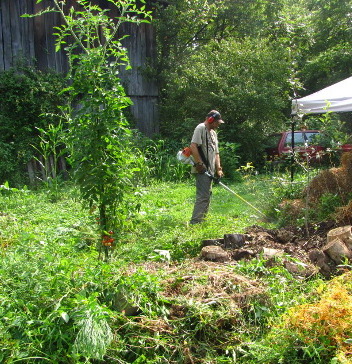 the post (and then rebar) whenever the top of the plant starts wanting
to bend down. A tomato vine in late summer can be very heavy, so
be sure to use heavy-duty ties --- like wire or plastic baling twine
--- rather than organic baling twine, or you'll have a tomato collapse.
the post (and then rebar) whenever the top of the plant starts wanting
to bend down. A tomato vine in late summer can be very heavy, so
be sure to use heavy-duty ties --- like wire or plastic baling twine
--- rather than organic baling twine, or you'll have a tomato collapse.
My final word of advice
is --- stake early! If you wait until your plants are starting to
bend down into the aisle, you'll risk breaking them off and will take
twice as long erecting stakes. Nowadays, I simply put the the
trellises and stakes in place before planting a single seed or set.
As if the beauty and
maneuverability of a well-staked garden isn't enough, I've discovered
that our fence posts have yet another advantage. Bluebirds and
phoebes love to perch on top of the posts, eating insects while
depositing droppings right where I need the extra fertility.
Thanks, guys!
Want more in-depth information? Browse through our books.
Or explore more posts by date or by subject.
About us: Anna Hess and Mark Hamilton spent over a decade living self-sufficiently in the mountains of Virginia before moving north to start over from scratch in the foothills of Ohio. They've experimented with permaculture, no-till gardening, trailersteading, home-based microbusinesses and much more, writing about their adventures in both blogs and books.
Want to be notified when new comments are posted on this page? Click on the RSS button after you add a comment to subscribe to the comment feed, or simply check the box beside "email replies to me" while writing your comment.
- Remove comment
 ) After they reached the top of the eight foot rebar, they kept growing, but I stopped tying them up, so they started to bend down. Total height was probably more like ten feet!
) After they reached the top of the eight foot rebar, they kept growing, but I stopped tying them up, so they started to bend down. Total height was probably more like ten feet!
- Remove comment
- Remove comment
